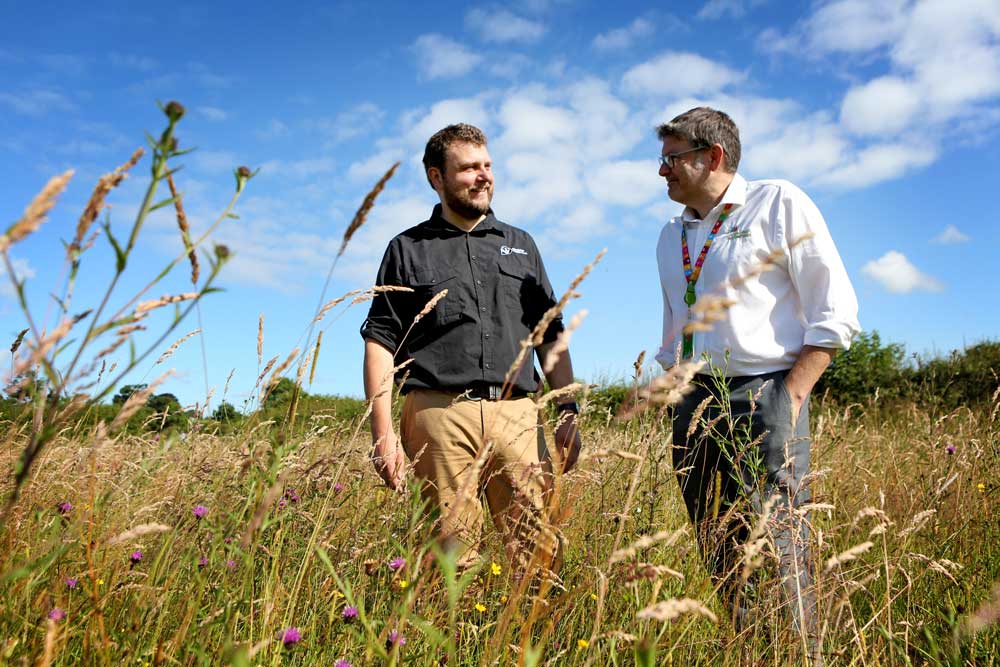Electricity network operator, SP Energy Networks is buzzing about an exciting new biodiversity project – delivered by Cheshire Wildlife Trust – that will restore local wildflower meadowland and provide food and shelter for bees and other insects.

The Bickley Boost for Bees project will create a further 6,200 square metres (0.62 hectares) of wildflower meadow – in addition to the existing 20 hectares – at the Trust’s Bickley Hall Farm HQ using ‘donor’ seed from a neighbouring field.
SP Energy Networks and Cheshire Wildlife Trust launched the project as the electricity network operator celebrated the publication of its first-ever biodiversity plan, Action Plan for Nature.
The plan sets out the actions SPEN is taking to minimise impacts on biodiversity and sets out ambitious targets to ensure its operations deliver ‘no net loss’ of biodiversity from its activities by 2028 and become ’nature positive’ for direct impacts by 2030.
Other targets include establishing 20 community partnership biodiversity projects by 2026 and delivering habitat enhancements on 25 hectares of land on the distribution network by 2028, helping provide a modern, reliable and resilient electricity network that works for both people and planet.
Jane McMillan, Head of Sustainability at SP Energy Networks, said: “We’re committed to minimising our impact on nature and improving our understanding of how our network interacts with the surrounding environment. Our action plan outlines the steps needed to achieve this by the end of the decade, aiming to halt the loss of biodiversity through our actions and transform our business to deliver nature-positive development and operations.
“We know there’s a lot of work involved, and developing partnerships, innovating and changing our processes are at the heart of this. The Bickley Boost for Bees project is a terrific example of that commitment in action.”
The first phase of the wildflower meadow creation project gets underway this month and will run until October. It’s hoped the new meadow will encourage more wildlife to flourish while ensuring the continued growth of unique wildflowers native to the region.
One square metre of wildflower meadow can be home to 570 flowers on a single day. They act as a ‘supermarket’ for bees and other insects and provide food, shelter and a place to lay their eggs, which in turn provides food for other wildlife like birds, bats and small mammals.*
Ben Gregory, Director of Nature Recovery at Cheshire Wildlife Trust said: “As a charity, we rely on donations to help support our work to bring back wildlife across Cheshire and this support from SP Energy Networks will enable us to enhance some key habitats at Bickley Hall Farm.
“Over the last 60 years or so, we’ve lost 99 per cent of our wildflower meadows in Cheshire, which has had catastrophic impacts on pollinators and ground nesting farmland birds. The funding from SP Energy Networks will directly contribute to our aims of restoring 300 hectares of wildflower meadow across Cheshire by 2030.”
Scott Irvine, SP Energy Networks’ Production Manager, identified the opportunity to work with Cheshire Wildlife Trust when planning 43km of overhead line refurbishment that’s part of a £5 million investment to upgrade the electricity network across Cheshire.
He said: “We all have a responsibility to do everything we can to preserve and enhance our natural environment and we’re proactively working to improve biodiversity within local communities across our network.
“Our partnership with the Cheshire Wildlife Trust is the perfect example of how we can do that and deliver a sustainable future that works for the environment and for society. This new wildflower meadow won’t just look good – it will be doing good and helping reverse the decline of wild pollinators including bumblebees, hoverflies and solitary bees.
“It proves that large infrastructure projects can happily co-exist with wildlife, enrich habitats and improve our biodiversity. We’re absolutely buzzing to be a part of that!”
SP Energy Networks biodiversity report, Action Plan for Nature, can be read in full at: SP_Energy_Networks_Action_Plan_for_Nature.pdf